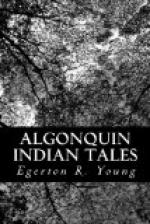“’You may well say ‘Zeeng, Zeeng,’ in your burning. I will teach you a lesson you will remember for not telling me that the Indians were stealing my roasted waterfowl.’
“Nanahboozhoo then went on his way, but in spite of his magic powers he felt a sort of a soreness in his back. He twisted his head around and saw the blisters that had been made by the fierce fire. So he thought how he must get rid of them, for they bothered him, although nothing could injure him for very long. While walking on the edge of a precipice he slipped—and away he slid, far down the rocky side. When he reached the bottom, he looked back, and there, on the rock, on which he had slid down, he saw things which he had never seen before.
“‘My nephews,’ said Nanahboozhoo, ’when they see these things on the rocks, will call them Wau-konug (lichen), and although they are poor food they will keep them from starving when they have nothing better.’
“This is the Indian tradition of the origin of the patches of lichen attached to the bare rocks. The Indians still call them ‘no-scabs,’ and when boiled they make a kind of jelly food which is a little better than starvation.
“Then Nanahboozhoo, although his back was bleeding from his sliding down the rough rocks, continued walking, sometimes along the shore and sometimes in the thick bush. In one place where the thicket was very dense such was his magic power that he pulled a lot of the thickets together and walked over on their tops. When he looked back he saw that the blood from the wounds in his back had given a red color to the bushes over which he had walked. Then said Nanahboozhoo:
“’My nephews will call these bushes “Me-squah-be-me-sheen” (red willows). They will use them to stop bleeding when they meet with any severe accidents;’ and such the Indians still do when they live among them.
“This is the tradition as to the origin of the red willow, once so common in many of the Indian haunts.
“The reason why the partridge is called Kosh-ko-e-wa-soo (one that startles) is because one made even Nanahboozhoo give a big jump. It happened in this way:
“As Nanahboozhoo was walking along one day in the woods he saw a small creature. This little thing thought it would be best for him to be brave in the presence of Nanahboozhoo, and so when he was asked who he was he answered:
“‘I am one who startles.’
“‘You cannot startle me,’ said Nanahboozhoo.
“The little creature suddenly flew away and Nanahboozhoo resumed his journey. By and by he reached a dangerous rocky point on the shore. Just as he was at the worst point the partridge suddenly flew almost from under his feet with a rumbling noise, and so startled him that he jumped up, sprang quickly aside, fell into the water, and got a great wetting. So even Nanahboozhoo had to confirm the name of the little partridge.”
The return trip was not much enjoyed by the children. The dead loons in the canoe did not look as attractive as they had appeared when swimming and diving so gracefully in the lake. Souwanas was quick to notice their depression of spirits, and he there and then resolved that he would never again shoot any living thing in their presence, and he faithfully kept his resolve.




